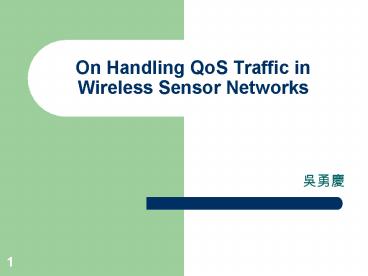On Handling QoS Traffic in Wireless Sensor Networks - PowerPoint PPT Presentation
1 / 16
Title:
On Handling QoS Traffic in Wireless Sensor Networks
Description:
QoS in Wireless Sensor Network. System Architecture and Design. Wired V.S. Wireless Networks ... Multi- or single function (e.g. relaying, sensing, aggregation) ... – PowerPoint PPT presentation
Number of Views:75
Avg rating:3.0/5.0
Title: On Handling QoS Traffic in Wireless Sensor Networks
1
On Handling QoS Traffic in Wireless Sensor
Networks
- ???
2
Outlines
- QoS in Wireless Sensor Network
- System Architecture and Design
- Wired V.S. Wireless Networks
- QoS Challenges in Sensor Network
- QoS Routing
- MAC Level Support
3
QoS in Wireless Sensor Network (1/2)
- Energy consideration has dominated most of
research in sensor networks - Latency, throughput and delay jitter were not
primary concerns - The increasing interest in real-time applications
along with the introduction of imaging and video
sensors has posed additional challenges - For instance, the transmission of imaging and
video data requires careful handling in order to
ensure that end-to-end delay is within acceptable
range and the variation in such delay is
acceptable
4
QoS in Wireless Sensor Network (2/2)
- Such performance metrics are usually referred to
as QoS of the communication network - Collecting sensed imaging and video data requires
both energy and QoS aware network protocols
5
System Architecture and Design (1/2)
- Network Dynamics
- Three main components, sensor nodes, sink,
monitored events - Most of the network architectures assume that
sensor nodes are stationary, but the mobility of
sinks or sensor nodes are sometimes necessary - The sensed event can be either dynamic or static
depending on the application - Node Deployment
- Deterministic
- Ad Hoc
- Data Aggregation/Fusion
- Suppression (eliminating duplicates), min, max,
and average
6
System Architecture and Design (2/2)
- Node Capabilities
- Multi- or single function (e.g. relaying,
sensing, aggregation) - Homogeneous or heterogeneous (e.g. cluster-head,
normal) - Node Communications
- Almost multi-hop
- Data Delivery Models
- Continuous (periodically)
- Event-driven
- Query-driven
- Hybrid
7
Wired V.S. Wireless Networks
- QoS routing is usually performed through resource
reservation in a connection-oriented
communication in order to meet the QoS
requirements for each individual connection - While wireless sensor networks are limited in
bandwidth, the use of reservation based protocols
for supporting QoS constrained traffic will be
impractical unless the network follows a
continuous data delivery model
8
QoS Challenges in Sensor Network (1/5)
- Bandwidth limitation
- Traffic in sensor networks can be burst with a
mixture of real-time and non-real-time traffic - Dedicating available bandwidth solely to QoS
traffic will not be acceptable - A trade-off in image/video quality may be
necessary to accommodate non-real-time traffic
9
QoS Challenges in Sensor Network (2/5)
- Removal of redundancy
- High redundancy in the generated data
- For unconstrained traffic, elimination of
redundant data messages is somewhat easy since
simple aggregation functions would suffice - Conducting data aggregation for QoS traffic is
much more complex - Comparison of images and video streams is not
computationally trivial and can consume
significant energy resources
10
QoS Challenges in Sensor Network (3/5)
- Another factor of consideration is the amount of
QoS traffic at a particular moment - For low traffic it may be more efficient to cease
data aggregation since the overhead would become
dominant
11
QoS Challenges in Sensor Network (4/5)
- Energy and delay trade-off
- Since the transmission power of radio is
proportional to the distance squared or even
higher order in noisy environments or in the non-
flat terrain , the use of multi-hop routing is
almost a standard in WSN - Although the increase in the number of hops
dramatically reduces the energy consumed for data
collection, the accumulative packet delay
magnifies - QoS routing of sensor data would have to
sacrifice energy efficiency to meet delivery
requirements - In addition, redundant routing of data may be
unavoidable to cope with the typical high error
rate in wireless communication, further
complicating the trade-off between energy
consumption and delay of packet delivery
12
QoS Challenges in Sensor Network (5/5)
- Buffer size limitation
- While a small buffer size can conceivably
suffice, buffering of multiple packets has some
advantages in wireless sensor networks - The transition of the radio circuitry between
transmission and reception modes consumes
considerable energy and thus it is advantageous
to receive many packets prior to forwarding them - Data aggregation and fusion involves multiple
packets - Delay jitter
13
QoS Routing (1/2)
- Two categories
- The first category focuses on the energy and
delay trade-off without much consideration to the
other issues - The second category strives to spread traffic in
order to effectively boost the bandwidths and
lower the delay - E.g. SAR, Energy-Aware QoS Routing Protocol,
SPEED
14
QoS Routing (2/2)
- In order to support both
- best effort and real-time
- traffic at the same time,
- a class-based queuing
- model is employed
15
MAC Level Support (1/2)
- Many energy-aware MAC protocols have been
proposed for sensor networks - Very little research has been done to combine
real-time scheduling techniques and
energy-awareness - Caccamo et al. have proposed an implicit
prioritized access protocol for sensor networks
which utilizes Earliest Deadline First (EDF)
scheduling algorithm in order to ensure
timeliness for real-time traffic
16
MAC Level Support (2/2)
- RAP 50 is another project that considers a
real-time scheduling policy for sensor networks - RAP is a communication architecture for sensor
networks that proposes velocity-monotonic
scheduling in order to minimize deadline miss
ratios for packets - Each packet is put to a different FIFO queue
based on their requested velocity, i.e. the
deadline and closeness to the gateway - This ensures a prioritization in the MAC layer
- An extension of IEEE 802.11 is used along with
such prioritization































